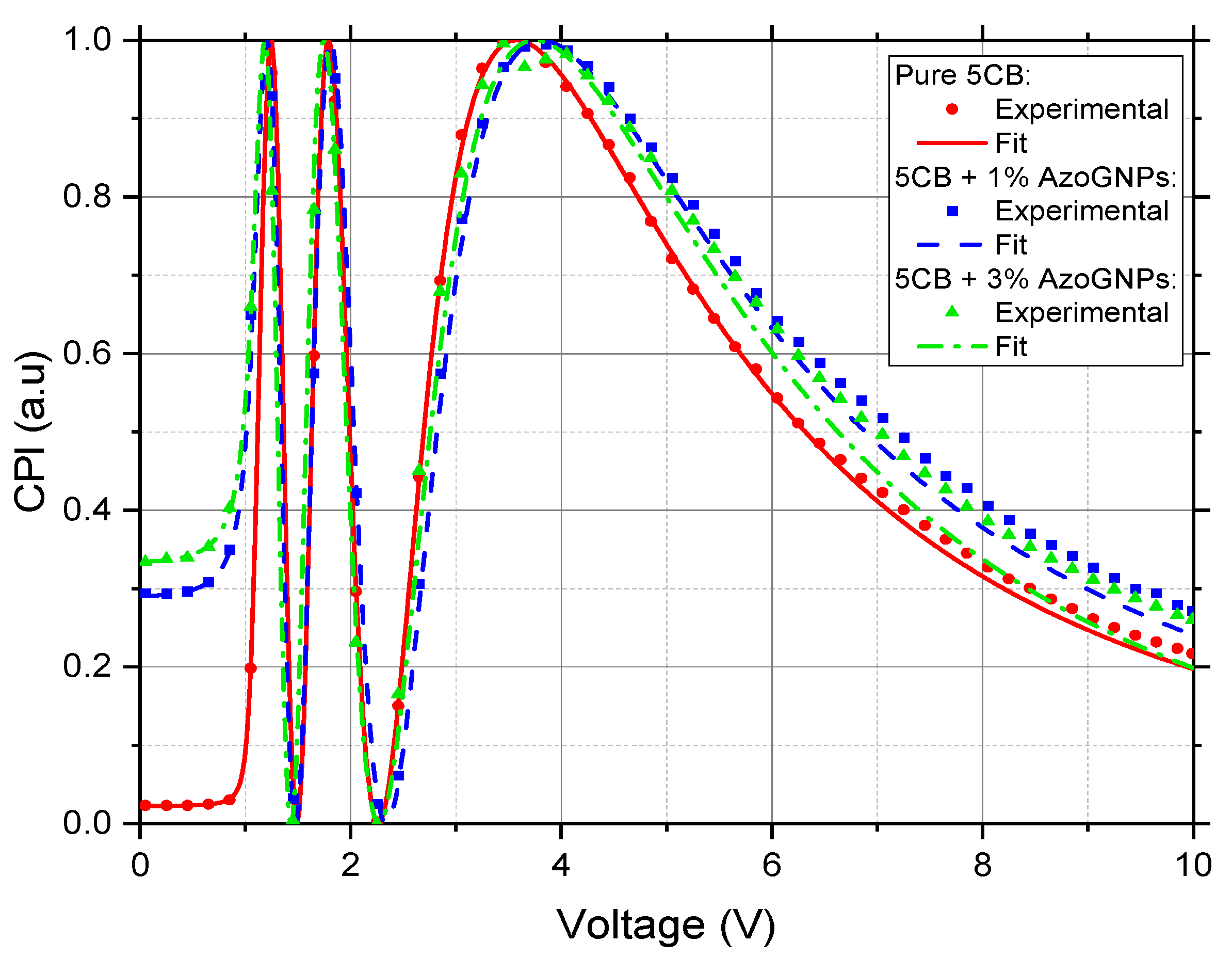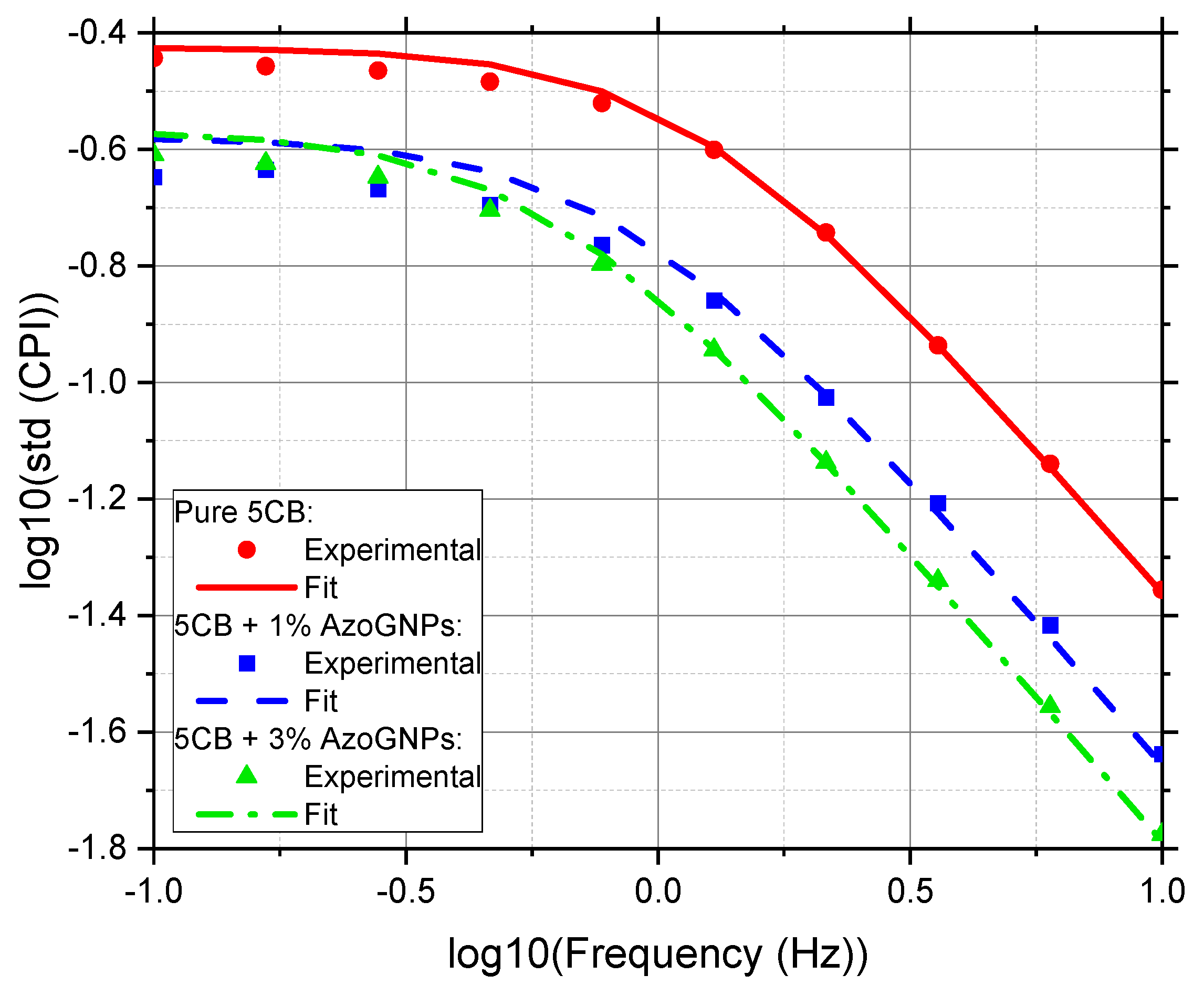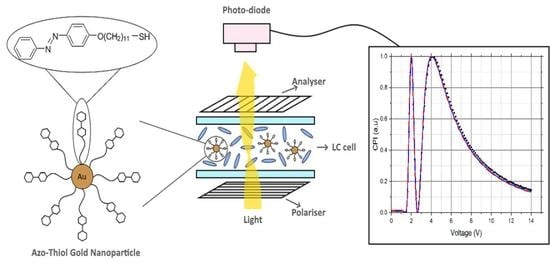Nanoparticle-Induced Property Changes in Nematic Liquid Crystals
Abstract
:1. Introduction
2. Materials and Methods
2.1. Particles Synthesis
2.2. Suspension Preparation
2.3. Cell Preparation
2.4. CPI and Viscosity Measurements
3. Results and Discussion
3.1. Elastic Constants of AzoGNPs-Doped Liquid Crystals
3.2. Rotational Viscosity Measurements
3.3. Elastic Constants and Stability of Ferroelectric Nanoparticle-Doped LCs
4. Conclusions
Supplementary Materials
Author Contributions
Funding
Institutional Review Board Statement
Informed Consent Statement
Data Availability Statement
Conflicts of Interest
References
- Shen, Y.; Dierking, I. Perspectives in Liquid-Crystal-Aided Nanotechnology and Nanoscience. Appl. Sci. 2019, 9, 2512. [Google Scholar] [CrossRef] [Green Version]
- Munna, M.; Anwar, F.; Coutu, R.A. Nematic Liquid Crystal Composite Materials for DC and RF Switching. Technologies 2019, 7, 32. [Google Scholar] [CrossRef] [Green Version]
- Kumar, A.; Singh, D.P.; Singh, G. Recent progress and future perspectives on carbon-nanomaterial-dispersed liquid crystal composites. J. Phys. D Appl. Phys. 2022, 55, 38. [Google Scholar] [CrossRef]
- Ayeb, H.; Alaya, S.; Derbali, M.; Samet, L.; Bennaceur, J.; Jomni, F.; Soltani, T. Dielectrical, electro-optical and textural studies of 5CB nematic liquid crystal doped with TiO2 and Cu-TiO2 nanoparticle. Liq. Cryst. 2021, 48, 223–232. [Google Scholar] [CrossRef]
- Mirzaei, J.; Urbanski, M.; Kitzerow, H.S.; Hegmann, T. Synthesis of liquid crystal silane-functionalized gold nanoparticles and their effects on the optical and electro-optic properties of a structurally related nematic liquid crystal. Chemphyschem 2014, 15, 1381–1394. [Google Scholar] [CrossRef]
- Roy, A.; Singh, B.P.; Yadav, G.; Khan, H.; Kumar, S.; Srivastava, A.; Manohar, R. Effect of gold nanoparticles on intrinsic material parameters and luminescent characteristics of nematic liquid crystals. J. Mol. Liq. 2019, 295, 111872. [Google Scholar] [CrossRef]
- Sano, S.; Miyama, T.; Takatoh, K.; Kobayashi, S. Enhancement of the characteristics of LCDs by doping nanoparticles: Reduction of the operating voltage, viscosity, and response times. In Proceedings of the SPIE 6135, Liquid Crystal Materials, Devices, and Applications XI, 613501. Event: Integrated Optoelectronic Devices 2006, San Jose, CA, USA, 23 February 2006. [Google Scholar] [CrossRef]
- Tripathi, P.K.; Misra, A.K.; Manohar, S.; Gupta, S.K.; Manohar, R. Improved dielectric and electro-optical parameters of ZnO nano-particle (8% Cu2+) doped nematic liquid crystal. J. Mol. Struct. 2013, 1035, 371–377. [Google Scholar] [CrossRef]
- Pandey, A.S.; Dhar, R.; Kumar, S.; Dabrowski, R. Enhancement of the display parameters of 4′-pentyl-4-cyanobiphenyl due to the dispersion of functionalised gold nano particles. Liq. Cryst. 2011, 38, 115–120. [Google Scholar] [CrossRef]
- Singh, U.B.; Dhar, R.; Dabrowski, R.; Pandey, M.B. Enhanced electro-optical properties of a nematic liquid crystals in presence of BaTiO3 nanoparticles. Liq. Cryst. 2014, 41, 953–959. [Google Scholar] [CrossRef]
- Garbovskiy, Y.; Glushchenko, A. Ferroelectric Nanoparticles in Liquid Crystals: Recent Progresss and Current Challenges. Nanomaterials 2017, 7, 361. [Google Scholar] [CrossRef] [Green Version]
- Al-Zangana, S.; Turner, M.; Dierking, I. A comparison between size dependent paraelectric and ferroelectric BaTiO3 nanoparticle doped nematic and ferroelectric liquid crystals. J. Appl. Phys. 2017, 121, 085105. [Google Scholar] [CrossRef] [Green Version]
- Evans, D.R.; Cook, G.; Reshetnyak, V.Y.; Liebig, C.M.; Basun, S.A.; Banerjee, P.P. Inorganic–Organic Photorefractive Hybrids. In Photorefractive Organic Materials and Applications; Springer Series in Materials Science; Blanche, P.A., Ed.; Springer: Cham, Switzerland, 2016; Volume 240. [Google Scholar] [CrossRef]
- Kaczmarek, M.; Buchnev, O.; Nandhakumar, I. Ferroelectric nanoparticles in low refractive index liquid crystals for strong electro-optic response. Appl. Phys. Lett. 2008, 92, 87. [Google Scholar] [CrossRef] [Green Version]
- Lena, M.; Lopatina; Jonathan, V. Maier-Saupe-type theory of ferroelectric nanoparticles in nematic liquid crystals. Selinger Phys. Rev. 2011, 84, 041703. [Google Scholar]
- Chausov, D.N.; Kurilov, A.D.; Kucherov, R.N.; Simakin, A.V.; Gudkov, S.V. Electro-optical performance of nematic liquid crystals doped with gold nanoparticles. J. Phys. Condens. Matter 2020, 32, 395102. [Google Scholar] [CrossRef]
- Acreman, A.; Kaczmarek, M.; D’Alessandro, G. Gold nanoparticle liquid crystal composites as a tunable nonlinear medium. Phys. Rev. 2014, 90, 012504. [Google Scholar] [CrossRef] [PubMed] [Green Version]
- Lysenko, D.; Ouskova, E.; Ksondzyk, S.; Reshetnyak, V.; Cseh, L.; Meh, G.H.; Reznikov, Y. Light-induced changes of the refractive indices in a colloid of gold nanoparticles in a nematic liquid crystal. Eur. Phys. J. E 2012, 35, 33. [Google Scholar] [CrossRef] [PubMed]
- Podoliak, N.; Bartczak, D.; Buchnev, O.; Kanaras, A.G.; Kaczmarek, M. High Optical Nonlinearity of Nematic Liquid Crystals Doped with Gold Nanoparticles. J. Phys. Chem. C 2012, 116, 12934–12939. [Google Scholar] [CrossRef]
- Xue, C.; Xiang, J.; Nemati, H.; Gutierrez-Cuevas, H.K.B.K.; Wang, L.; Gao, M.; Zhou, S.; Yang, D.; Lavrentovich, O.D.; Urbas, A.; et al. Light-Driven Reversible Alignment Switching of Liquid Crystals Enabled by Azo Thiol Grafted Gold Nanoparticles. ChemPhysChem 2015, 16, 1852–1856. [Google Scholar] [CrossRef] [PubMed]
- Milette, J.; Toader, V.; Reven, L.; Lennox, R.B. Tuning the miscibility of gold nanoparticles dispersed in liquid crystals via the thiol-for-DMAP reaction. J. Mater. Chem. 2011, 21, 9043. [Google Scholar] [CrossRef]
- Mirzaei, J.; Reznikov, M.; Hegmann, T. Quantum dots as liquid crystal dopants. J. Mater. Chem. 2012, 22, 22350–22365. [Google Scholar] [CrossRef] [Green Version]
- Singh, U.B.; Dhar, R.; Pandey, A.S.; Kumar, S.; Dabrowski, R.; Pandey, M.B. Electro-optical and dielectric properties of CdSe quantum dots and 6CHBT liquid crystals composites. AIP Adv. 2014, 4, 117112. [Google Scholar] [CrossRef]
- Konshina, E.A.; Galin, I.F.; Shcherbinin, D.P.; Gavrish, E.O. Study of dynamics and relaxation optical response of nematic liquid crystals doped with CdSe/ZnS quantum dots. Liq. Cryst. 2014, 41, 1229–1234. [Google Scholar] [CrossRef]
- Gupta, S.K.; Singh, D.P.; Tripathi, P.K.; Manohar, R.; Varia, M.; Sagar, L.K.; Kumar, S. CdSe quantum dot-dispersed DOBAMBC: An electro-optical study. Liq. Cryst. 2013, 40, 528–533. [Google Scholar] [CrossRef]
- Rastogi, A.; Pathak, G.; Srivastava, A.; Herman, J.; Manohar, R. Cd1−X ZnXS/ZnS core/shell quantum dots in nematic liquid crystals to improve material parameter for better performance of liquid crystal-based devices. J. Mol. Liq. 2018, 255, 93–101. [Google Scholar] [CrossRef]
- Satapathy, P.; Vasudeva, N.; Oinam, J.; Prasad, S.K. Enhanced luminescence, electric-field and actinic-light modulation of emission in nematic-CdSeS gradient nanocrystal composites by polymer confinement. J. Mol. Liq. 2021, 46, 1595–1604. [Google Scholar] [CrossRef]
- Satapathy, P.; Santra, P.K.; Haque, A.; Yelamaggad, C.V.; Das, S.; Prasad, S.K. Anisotropic Fast Electrically Switchable Emission from Composites of CsPbBr3 Perovskite Quantum Cuboids in a Nematic Liquid Crystal. Adv. Opt. Mater. 2019, 7, 1801408. [Google Scholar] [CrossRef]
- Joshi, T.; Kumar, A.; Prakash, J.; Biradar, A.M. Low power operation of ferroelectric liquid crystal system dispersed with zinc oxide nanoparticles. Appl. Phys. Lett. 2010, 96, 253109. [Google Scholar] [CrossRef] [Green Version]
- Podoliak, N.; Buchnev, O.; Buluy, O.; D’Alessandro, G.; Kaczmarek, M.; Reznikov, Y.; Sluckin, T.J. Macroscopic optical effects in low concentration ferronematics. Soft Matter 2011, 7, 4742–4749. [Google Scholar] [CrossRef]
- Tóth-Katona, T.; Gdovinová, V.; Tomašovičová, N.; Éber, N.; Fodor-Csorba, K.; Juríková, A.; Závišová, V.; Timko, M.; Chaudc, X.; Kopčanský, P. Tuning the phase transition temperature of ferronematics with a magnetic field. Soft Matter 2018, 14, 1647–1658. [Google Scholar] [CrossRef] [PubMed] [Green Version]
- Gdovinová, V.; Schroer, M.A.; Tomašovičová, N.; Appel, I.; Behrens, S.; Majorošová, J.; Kováč, J.; Svergunb, D.I.; Kopčanskýa, P. Structuralization of magnetic nanoparticles in 5CB liquid crystals. Soft Matter 2017, 13, 7890–7896. [Google Scholar] [CrossRef]
- Vardanyan, K.K.; Sita, D.M.; Walton, R.D.; Saidel, W.M.; Jones, K.M. Cyanobiphenyl liquid crystal composites with gold nanoparticles. RSC Adv. 2013, 3, 259. [Google Scholar] [CrossRef]
- Perivolari, E.; D’Alessandro, G.; Apostolopoulos, V.; Brouckaert, N.; Heiser, T.; Kaczmarek, M. Two-dimensional snapshot measurement of surface variation of anchoring in liquid crystal cells. Liq. Cryst. 2021, 48, 2086–2096. [Google Scholar] [CrossRef]
- Podoliak, N.; Buchnev, O.; Herrington, M.; Mavrona, E.; Kaczmarek, M.; Kanaras, A.G.; Stratakis, E.; Blach, J.F.; Henninot, J.F.; Warenghem, M. Elastic constants, viscosity and response time in nematic liquid crystals doped with ferroelectric nanoparticles. RSC Adv. 2014, 4, 46068–46074. [Google Scholar] [CrossRef]
- Brust, M.; Schiffrin, D.J.; Bethell, D.; Kiely, C.J. Novel gold-dithiol nano-networks with non-metallic electronic properties. Adv. Mater. 1995, 7, 795–797. [Google Scholar] [CrossRef]
- Herrington, M.R.; Buchnev, O.; Kaczmarek, M.; Nandhakumar, I. The Effect of the Size of BaTiO3 Nanoparticles on the Electro-Optic Properties of Nematic Liquid Crystals. Mol. Cryst. Liq. Cryst. 2010, 527, 72–228. [Google Scholar] [CrossRef]
- Demus, D.; Inukai, T. Calculation of molecular, dielectric and optical properties of 4′-n-pentyl-4-cyano-biphenyl (5CB). Liq. Cryst. 1999, 26, 1257–1266. [Google Scholar] [CrossRef]
- Bennett, T.P.; Proctor, M.B.; Kaczmarek, M.; D’Alessandro, G. Lifting degeneracy in nematic liquid crystal viscosities with a single optical measurement. J. Colloid Interface Sci. 2017, 497, 201–206. [Google Scholar] [CrossRef] [Green Version]
- Bennett, T.; Proctor, M.; Forster, J.; Perivolari, E.; Podoliak, N.; Sugden, M.; Kirke, R.; Regrettier, T.; Heiser, T.; Kaczmarek, M.; et al. Wide area mapping of liquid crystal devices with passive and active command layers. Appl. Opt. 2017, 56, 9050–9056. [Google Scholar] [CrossRef] [PubMed]
- Cui, M.; Kelly, J.R. Temperature Dependence of Visco-Elastic Properties of 5CB. Mol. Cryst. Liq. Cryst. Sci. Technol. Sect. A. Mol. Cryst. Liq. Cryst. 1999, 331, 49–57. [Google Scholar] [CrossRef]
- Vardanyan, K.K.; Sita, D.M.; Walton, R.D.; Gurfinkiel, I.S.; Saidel, W.M. Liquid crystalline cyanobiphenyl homologues doped with gold nanoparticles. Liq. Cryst. 2012, 39, 1083–1098. [Google Scholar] [CrossRef]
- Reznikov, Y.; Buchnev, O.; Tereshchenko, O.; Reshetnyak, V.; Glushchenko, A.; West, J. Ferroelectric nematic suspension. Appl. Phys. Lett. 2003, 82, 1917–1919. [Google Scholar] [CrossRef]
- Li, F.; Buchnev, O.; Cheon, C.; Glushchenko, A.; Reshetnyak, V.; Reznikov, Y.; Sluckin, T.J.; West, J.L. Orientational coupling amplification in ferroelectric nematic colloids. Phys. Rev. Lett. 2006, 97, 147801. [Google Scholar] [CrossRef] [Green Version]
- Bennett, T.P.; D’Alessandro, G.; Daly, K.R. Multiscale models of colloidal dispersion of particles in nematic liquid crystals. Phys. Rev. 2014, 90, 062505. [Google Scholar] [CrossRef] [PubMed] [Green Version]
- Bennett, T.P.; D’Alessandro, G.; Daly, K.R. Multiscale Models of Metallic Particles in Nematic Liquid Crystals. SIAM J. Appl. Math. 2018, 78, 1228–1255. [Google Scholar] [CrossRef] [Green Version]




| λ (nm) | K1 (pN) | K3 (pN) | ε// | ε⊥ | Δε | γ1 (mPa.s) | |
|---|---|---|---|---|---|---|---|
| 5CB | 642 | 6.0 | 9.0 | 17.9 | 6.5 | 11.4 | 92.50 |
| 5CB + 1%AzoGNPs | 642 | 6.3 | 9.3 | 21.8 | 11.4 | 10.4 | 98.41 |
| 5CB + 3%AzoGNPs | 642 | 4.1 | 7.5 | 24.3 | 17.5 | 6.8 | 89.03 |
| E7 | 642 | 10.7 | 16.2 | 19.5 | 5.2 | 14.4 | 203 |
| E7 + 1%AzoGNPS | 642 | 8.9 | 16.6 | 17.6 | 7.5 | 10.1 | 148.17 |
| LC18523 | 532 | 8.2 | 9.1 | 6.7 | 4.2 | 2.5 | 92.7 |
| LC18523 + 1%SPS | 532 | 6.5 | 11.0 | 11.5 | 4.7 | 6.8 | 128.58 |
| λ (nm) | K1 (pN) | K3 (pN) | |
|---|---|---|---|
| Pure LC18523 (literature [35]) | 633 | 7.85 | 10.0 |
| Pure LC18523 (OMPA fit of [35]) | 633 | 7.9 | 10.1 |
| Pure LC18523 (OMPA new measurements) | 532 | 8.2 | 9.1 |
| LC18523 + 1 wt% SPS (literature [35]) | 633 | 7.1 | 10.5 |
| LC18523 + 1 wt% SPS (OMPA fit of [35]) | 633 | 7.3 | 10.5 |
| LC18523 + 1 wt% SPS (OMPA new measurements) | 532 | 6.5 | 11.0 |
Publisher’s Note: MDPI stays neutral with regard to jurisdictional claims in published maps and institutional affiliations. |
© 2022 by the authors. Licensee MDPI, Basel, Switzerland. This article is an open access article distributed under the terms and conditions of the Creative Commons Attribution (CC BY) license (https://creativecommons.org/licenses/by/4.0/).
Share and Cite
Brouckaert, N.; Podoliak, N.; Orlova, T.; Bankova, D.; De Fazio, A.F.; Kanaras, A.G.; Hovorka, O.; D’Alessandro, G.; Kaczmarek, M. Nanoparticle-Induced Property Changes in Nematic Liquid Crystals. Nanomaterials 2022, 12, 341. https://doi.org/10.3390/nano12030341
Brouckaert N, Podoliak N, Orlova T, Bankova D, De Fazio AF, Kanaras AG, Hovorka O, D’Alessandro G, Kaczmarek M. Nanoparticle-Induced Property Changes in Nematic Liquid Crystals. Nanomaterials. 2022; 12(3):341. https://doi.org/10.3390/nano12030341
Chicago/Turabian StyleBrouckaert, Nicolas, Nina Podoliak, Tetiana Orlova, Denitsa Bankova, Angela F. De Fazio, Antonios G. Kanaras, Ondrej Hovorka, Giampaolo D’Alessandro, and Malgosia Kaczmarek. 2022. "Nanoparticle-Induced Property Changes in Nematic Liquid Crystals" Nanomaterials 12, no. 3: 341. https://doi.org/10.3390/nano12030341
APA StyleBrouckaert, N., Podoliak, N., Orlova, T., Bankova, D., De Fazio, A. F., Kanaras, A. G., Hovorka, O., D’Alessandro, G., & Kaczmarek, M. (2022). Nanoparticle-Induced Property Changes in Nematic Liquid Crystals. Nanomaterials, 12(3), 341. https://doi.org/10.3390/nano12030341







